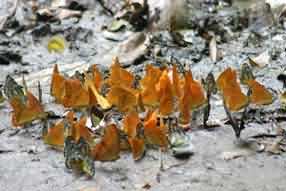 Laiwangi Wanggameti National Park is geographically consists of hills, valleys, and wavy regions, located in East Sumba, East Nusa Tenggara Province, Indonesia.
Laiwangi Wanggameti National Park is geographically consists of hills, valleys, and wavy regions, located in East Sumba, East Nusa Tenggara Province, Indonesia.
History
In the age of the Dutch colonial, this forest is already declared as protected area. The status of this forest then setbased on the Decree Hydrologisch Reserve Regent Regional No. TK II East Sumba. 9/Pemb.1/3 dated January 30, 1965.
In 1983 based on Ministry of Forestry Decree No. TGHK through.
89/Kpts-II/1983 date December 2, 1983, this 667,962 acres area has been
assigned to be remain in the province of East Nusa Tenggara.
Under Decree of Indonesia Forest Ministry No. 576/Kpts-II/1998, the forest designated as National Parks from an area of ??47,014 ha 50, but within Laiwangi Wanggameti decree makes no mention of the “enclave” that in fact there are two villages in the region namely Ramuk and Katikuai. Commencing in 2006/2007 Ramuk village has blossomed into 2 villages named Mahaniwa and Ramuk,
the enclave villages have an area of more than 4447 acress. Both Ramuk
and Katikuai is seen as pockets of the population and the subsequent
need for clarification through the process of establishing enclaves
Wanggameti definitive boundaries.
 Laiwangi Wanggameti general topography is hilly, with a rather steep
slopes to extreme steep. Topography is rather flat to undulating located
on the southeast and south, while in the west and east has a hilly to
mountainous topography with slopes having a bit steep to very steep.
Laiwangi Wanggameti general topography is hilly, with a rather steep
slopes to extreme steep. Topography is rather flat to undulating located
on the southeast and south, while in the west and east has a hilly to
mountainous topography with slopes having a bit steep to very steep.
East Sumba has 7 Watershed, namely: Kambaniru 111,000 acres, Kaliongga 55,000 acres, Melolo 45,000 acres, Kadahang 40,000 acres, Nggongi 26,000 acres, Tidas 33,000 acres and Watumbaka 23,000 acres.
Flora And Fauna
In this area there are types of plants such as Pulai (Alstonia scholaris), guava forests (Syzygium sp.), cinnamon (Cinnamomum zeylanicum), suren ( Toona sureni), banyan (Ficus sp.), Nuts (Canarium oleosum),honggi (Myristica littoralis), taduk (Sterculia foetida), kesambi (Schleichera oleosa), and hangkang (Palaquium obovatum).
Fauna
 Laiwangi-Wanggameti National Parks is the habitat of
some wildlife such as long-tailed macaque (Macaca fascicularis
fascicularis), wild boar (Sus sp.), Monitor lizard (Varanus salvator),
Timor python (Python timorensis), and jungle fowl (Gallus Gallus) . In
addition, a major population of birds Walik rawamanu (Ptilinopus dohertyi), Sumba pigeon (Treron teysmannii) and various other bird
species such as gemak Sumba (Turnix everetti), cockatoos cempaka
(Cacatua sulphurea citrinocristata), parrots (Lorius domicella), sweep
Sumba ( Ficedula harterti), orioles-sungu Sumba (Coracina dohertyi), and
honey Sumba (Nectarinia buettikoferi)
Laiwangi-Wanggameti National Parks is the habitat of
some wildlife such as long-tailed macaque (Macaca fascicularis
fascicularis), wild boar (Sus sp.), Monitor lizard (Varanus salvator),
Timor python (Python timorensis), and jungle fowl (Gallus Gallus) . In
addition, a major population of birds Walik rawamanu (Ptilinopus dohertyi), Sumba pigeon (Treron teysmannii) and various other bird
species such as gemak Sumba (Turnix everetti), cockatoos cempaka
(Cacatua sulphurea citrinocristata), parrots (Lorius domicella), sweep
Sumba ( Ficedula harterti), orioles-sungu Sumba (Coracina dohertyi), and
honey Sumba (Nectarinia buettikoferi)Recorded as many as 43 butterfly species including three endemic species in the Nusa Tenggara is a butterfly halipron (Troides haliphron NAIAS), Elimnias amoena, Sumalia Chilo, Ideopsis oberthurii, and Athyma karita.
Laiwangi-Wanggameti was just recently designated as a national park, so the facility for visitors is still very limited. Homestay accommodation is available in the form provided and managed by local communities.
Natural Attractions in the area Wanggameti Laiwangi that there are quite a lot with a beautiful panorama of waterfalls including Laputi waterfalls, waterfalls Kanabuai, Waikanabu waterfalls, waterfalls Kahalatau, Lake Laputi where there is the sacred eels (local people call it: “Apu” ).
Natural Attractions in the area Wanggameti Laiwangi that there are quite a lot with a beautiful panorama of waterfalls including Laputi waterfalls, waterfalls Kanabuai, Waikanabu waterfalls, waterfalls Kahalatau, Lake Laputi where there is the sacred eels (local people call it: “Apu” ).
The Ancient Tombs
 Around the Laiwangi-Wanggameti can be found many ancient tombs carved with a motif such as horses, buffalo, men and women. It’s a symbol of ancient tombs and social status of the family left behind.
Around the Laiwangi-Wanggameti can be found many ancient tombs carved with a motif such as horses, buffalo, men and women. It’s a symbol of ancient tombs and social status of the family left behind.
In the daily life, people of Sumba is divided into several stratas which are the Aristocratic, Kabihu, and Ata (ordinary
people). The activities of the non-ordinary blend in society in the
community of East Sumba to a bound called ‘kabihu’ which illustrate the
closeness of the bond order custom, especially in the sacred events like
funeral, marriage, and mutual cooperation within kin – relatives of
the family.
The relationship between the patrician and ata built with family and
kinship, even serung as the relationship between child and father. Traditional patterns such as this need dilesatrikan as one of East Sumba Ethnic pride
The best visiting season: March, s / d in June and October / December each
To be able to reach the National Park Laiwangi Wanggameti can go through:
- Water
With Merpati F-100 aircraft or Trigana everyday for 1 – 1.5 hours, through Kupang or Denpasar. - Sea
KM Fery – ASDP:
Kupang-Ende-Waingapu and takes about 36 hours
Kupang-Aimere-Waingapu and takes about 32 hours K Awu – PT.PELNI:
Kupang – Ende – Waingapu takes about 22 hours
Benoa – Waingapu and takes about 36 hours - Land
Waingapu – Laiwangi Wanggameti can be reach using four-wheel vehicles or motorcycles within 1-1.5 hours. - source : http://discoverindonesia.net






beautiful place and very suitable for holiday.
ReplyDeletealat sexualitas